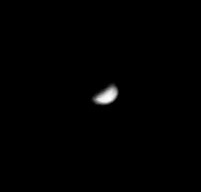If you go out tonight (March 1, 2017) or the next few nights you will see the crescent Moon and then to the right of it what appears to be a bright star. But that "star" is the planet Venus, which orbits the Sun closer than Earth does.
Though the skies were murky (as evidenced by the unsharpness of the Venus photo) I broke out my little
Bushnell NorthStar 90mm Catadioptric Telescope (OTA) and mount my Canon t3i to capture these two crescents in the evening sky. The first image is Venus (cropped). The second image is the Moon (of course!)
Venus is working its way between the Earth and the Sun and as it does so the thickness of the crescent will decrease each evening and Venus will drop lower and lower in the evening sky, drawing nearer and nearer to the Sun (from our perspective) until we will not be able to see Venus due to the glare of the Sun.
Compare the above shot to the one I took (in broad daylight) back in January (Jan. 30, 2017) and you will see the difference over time. (The distorted view is due to being out of alignment with a different scope.)
Crescent Moon (Mar. 1, 2017)
No, Venus is NOT that large compared to the Moon! In fact, the smallest crater you can see in the Moon shot is larger than Venus was in the frame of the camera!









